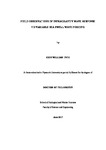FIELD OBSERVATIONS OF INFRAGRAVITY WAVE RESPONSE TO VARIABLE SEA-SWELL WAVE FORCING
| dc.contributor.supervisor | Davidson, Mark | |
| dc.contributor.author | Inch, Kris William | |
| dc.contributor.other | School of Biological and Marine Sciences | en_US |
| dc.date.accessioned | 2017-11-16T12:10:30Z | |
| dc.date.available | 2017-11-16T12:10:30Z | |
| dc.date.issued | 2017 | |
| dc.date.issued | 2017 | |
| dc.identifier | 373177 | en_US |
| dc.identifier.uri | http://hdl.handle.net/10026.1/10164 | |
| dc.description | Full version: Access restricted permanently due to 3rd party copyright restrictions. Restriction set on 16.11.2017 by SE, Doctoral College | |
| dc.description.abstract |
Infragravity waves are low frequency (0.005-0.04 Hz) waves that can dominate the spectrum of water motions and sediment transport processes within the inner surf zone. Despite the established importance of infragravity waves in shaping our coasts and numerous studies dating back to the 1950s, several aspects of infragravity wave analysis, generation and dissipation remain poorly understood. As much of the recent infragravity research has focussed on fetch-limited coasts, less is known about the climatology of these waves on energetic coastlines subject to both swell and fetch-limited waves. It has been postulated that bed friction only plays a significant role in the dissipation of infragravity waves where the bed is exceptionally rough, but the precise impact of bed roughness is not fully understood, particularly on extremely rough rock platforms. Finally, although there have been many methodologies proposed for the decomposition of reflective wave fields (an essential tool for studying infragravity wave dynamics), very little attention has been given to evaluating their accuracy, particularly the impact of uncorrelated noise. This study aims, primarily through the collection of an extensive field dataset and the establishment of accurate analysis tools, to provide new insight into the propagation, dissipation and reflection of infragravity waves on energetic coastlines of varied roughness, subject to both swell and fetch-limited waves. To ensure the accurate decomposition of infragravity wave signals into their incident and reflected components, a sensitivity analysis into the effect of uncorrelated noise on an array separation method is performed. Results show that signal noise, often prevalent in field data, introduces a significant bias to estimates of incident and reflected wave spectra, and corresponding reflection coefficients. This bias can exceed 100% for signal-to-noise ratios of <1. Utilising the systematic change in coherence with noise, a correction function is developed which is effective at reducing bias by up to 90%. When applied to field data, results imply that infragravity reflection coefficients can be overestimated by >50% if signal noise is unaccounted for. Consequently, noise reduction should form an integral part of future infragravity wave studies. New research from a dissipative, fetch-unlimited sandy beach (Perranporth, Cornwall, UK) and a macrotidal, rocky shore platform (Freshwater West, Pembrokeshire, UK) uniquely demonstrates that the level of infragravity wave energy close to shore is linearly dependent on the offshore short wave energy flux H_o^2 T_p (r^2 = 0.93and 0.79, respectively). Infragravity waves approach the coast as bound waves lagging slightly (~4 s) behind the wave group envelope and are released in the surf zone where their heights can exceed 1 m. Considerable infragravity dissipation is observed in the surf zone and is a function of both frequency and H_o^2 T_p. Complex Empirical Orthogonal Function (EOF) analysis reveals (quasi-)standing waves at low infragravity frequencies <0.017 Hz. Conversely, at higher frequencies (>0.017 Hz), infragravity waves demonstrated progressively more dissipation (up to 90%) and progressive wave characteristics, with increasing frequency. Much of the observed dissipation occurs very close to shore (h <0.8 m) and the dependence of the reflection coefficient on a normalised bed slope parameter implies a mild sloping bed regime at these high infragravity frequencies, suggesting that the observed dissipation is dominated by wave breaking processes. This is supported by the results of bispectral analysis which show predominantly infragravity-infragravity interactions in shallow water and the development of infragravity harmonics indicative of steepening and eventual breaking of the infragravity waves. This study presents the first simultaneous field observations of infragravity waves on a macrotidal, rocky shore platform and adjacent sandy beach. Infragravity wave dissipation is observed on both the platform and beach and occurs at statistically similar rates, demonstrating that frictional dissipation due to bed roughness is not the dominant dissipation mechanism, even in this extreme case. Sea-swell waves are also unaffected by the extreme roughness of the platform, with relative wave heights on the beach and platform (γ = 0.38 and 0.43, respectively) scaling well with their respective gradients and are in very close agreement with formulations derived from sandy beaches. Overall, bed roughness is shown to have no significant impact on infragravity or sea-swell wave transformation, with offshore forcing and bed slope being the main controlling factors, particularly under moderate to high energy offshore forcing. | en_US |
| dc.language.iso | en | |
| dc.publisher | University of Plymouth | |
| dc.subject | Waves | en_US |
| dc.subject | Beach | en_US |
| dc.subject | Infragravity | en_US |
| dc.subject | Coast | en_US |
| dc.subject | Geography | en_US |
| dc.subject | Erosion | en_US |
| dc.subject.classification | PhD | en_US |
| dc.title | FIELD OBSERVATIONS OF INFRAGRAVITY WAVE RESPONSE TO VARIABLE SEA-SWELL WAVE FORCING | en_US |
| dc.type | Thesis | |
| plymouth.version | non-publishable | en_US |
| dc.identifier.doi | http://dx.doi.org/10.24382/525 | |
| dc.identifier.doi | http://dx.doi.org/10.24382/525 | |
| dc.rights.embargoperiod | No embargo | en_US |
| dc.type.qualification | Doctorate | en_US |
| rioxxterms.version | NA |
Files in this item
This item appears in the following Collection(s)
-
01 Research Theses Main Collection
Research Theses Main


